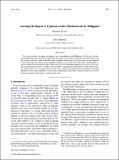Assessing the Impact of Typhoons on Rice Production in the Philippines
Author(s)
Strobl, Eric; Blanc, Elodie
DownloadBlanc_Assessing the impact.pdf (1.024Mb)
PUBLISHER_POLICY
Publisher Policy
Article is made available in accordance with the publisher's policy and may be subject to US copyright law. Please refer to the publisher's site for terms of use.
Terms of use
Metadata
Show full item recordAbstract
This study quantifies the impact of typhoons on rice production in the Philippines. To this end, satellite-derived reflectance data are used to detect the location of rice fields at 500-m resolution. Utilizing typhoon-track data within a wind field model and satellite-derived precipitation measures, fragility curves are then employed to proxy the damage of storms on rice production within each rice field. The results from a panel spatial regression model show that typhoons substantially reduced local provincial production in the quarter of the strike, having caused losses of up to 12.5 million tons since 2001. Using extreme value theory to predict future losses, the results suggest that a typhoon like the recent Haiyan, which is estimated to have caused losses of around 260 000 tons, has a return period of 13 years. This methodology can provide a relatively timely tool for rice damage assessments after tropical cyclones in the region.
Date issued
2016-04Department
MIT Energy InitiativeJournal
Journal of Applied Meteorology and Climatology
Publisher
American Meteorological Society
Citation
Blanc, Elodie, and Eric Strobl. “Assessing the Impact of Typhoons on Rice Production in the Philippines.” Journal of Applied Meteorology and Climatology 55.4 (2016): 993–1007. © 2016 American Meteorological Society
Version: Final published version
ISSN
1558-8424
1558-8432